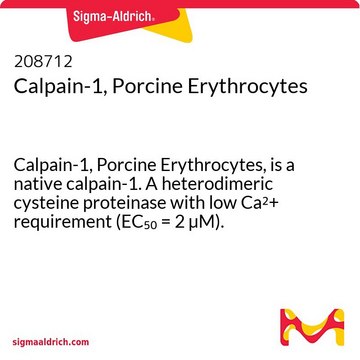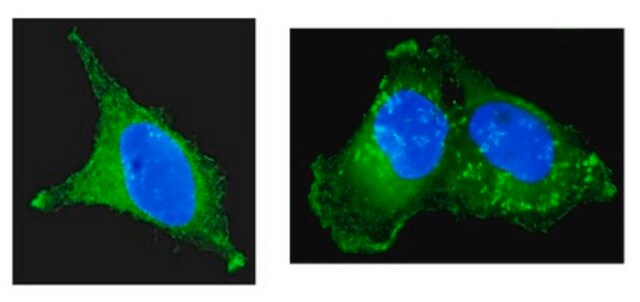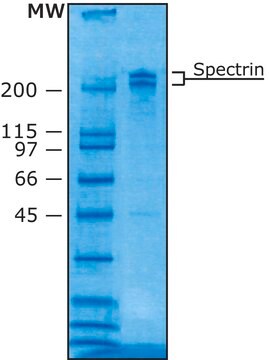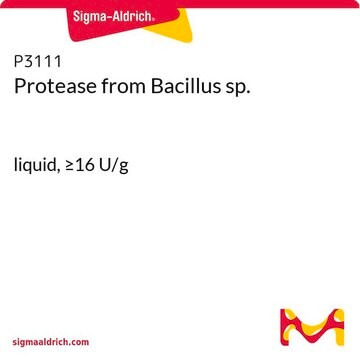208713
Calpain-1, Human Erythrocytes
Calpain-1, Human Erythrocytes, is a native calpain-1. A heterodimeric cysteine proteinase with low Ca2+ requirement (EC₅₀ = 2 µM).
Sinónimos:
μ-Calpain
Iniciar sesiónpara Ver la Fijación de precios por contrato y de la organización
About This Item
Productos recomendados
Nivel de calidad
Formulario
liquid
actividad específica
≥1000 units/mg protein
fabricante / nombre comercial
Calbiochem®
condiciones de almacenamiento
OK to freeze
avoid repeated freeze/thaw cycles
Condiciones de envío
wet ice
temp. de almacenamiento
−70°C
Descripción general
Native calpain-1 from human erythrocytes. Ca2+-dependent cysteine proteinase with low Ca2+ requirement (half-maximal activation = 2 µM). Participates in the ATP release reaction of platelets stimulated with thrombin.
Envase
Please refer to vial label for lot-specific concentration.
Advertencia
Toxicity: Harmful (C)
Definición de unidad
One unit is defined as the amount of enzyme that will hydrolyze 1 pmol Suc-LLVY-AMC in 1 min, 25°C using the Calpain Activity Assay Kit, Fluorogenic (Cat. No. QIA120). Note: 1 caseinolytic unit = 1 fluorogenic unit.
Forma física
In 20 mM imidazole, 5 mM β-mercaptoethanol, 1 mM EDTA, 1 mM EGTA, 30% glycerol, pH 6.8.
Nota de preparación
Prepared from blood that has been shown by certified tests to be negative for HBsAg and for antibodies to HIV and HCV.
Reconstitución
Following initial thaw, aliquot and freeze (-70°C).
Nota de análisis
Comparable to reference lot by SDS-PAGE
Otras notas
Vanderklish, P.W., and Bahr, B.A. 2000. Int. J. Exp. Pathol.81, 323.
Sorimachi, H., et al. 1997. Biochem. J. 328, 721.
Croall, D.E., and McGrody, K.S. 1994. Biochemistry33, 13223.
Sorimachi, H., et al. 1997. Biochem. J. 328, 721.
Croall, D.E., and McGrody, K.S. 1994. Biochemistry33, 13223.
Información legal
CALBIOCHEM is a registered trademark of Merck KGaA, Darmstadt, Germany
Código de clase de almacenamiento
10 - Combustible liquids
Clase de riesgo para el agua (WGK)
WGK 2
Certificados de análisis (COA)
Busque Certificados de análisis (COA) introduciendo el número de lote del producto. Los números de lote se encuentran en la etiqueta del producto después de las palabras «Lot» o «Batch»
¿Ya tiene este producto?
Encuentre la documentación para los productos que ha comprado recientemente en la Biblioteca de documentos.
Courtney Blachford et al.
Cell calcium, 46(4), 257-262 (2009-09-08)
Neuronal calcium sensor-1 (NCS-1) is a high-affinity, low-capacity Ca(2+)-binding protein expressed in many cell types. We previously showed that NCS-1 interacts with inositol 1,4,5-trisphosphate receptor (InsP(3)R) and modulates Ca(2+)-signaling by enhancing InsP3-dependent InsP(3)R channel activity and intracellular Ca(2+) transients. Recently
Peter Tompa et al.
The Journal of biological chemistry, 277(11), 9022-9026 (2002-01-26)
The inhibitory domains of calpastatin contain three highly conserved regions, A, B, and C, of which A and C bind calpain in a strictly Ca(2+)-dependent manner but have no inhibitory activity whereas region B inhibits calpain on its own. We
Olav A Gressner et al.
Journal of cellular and molecular medicine, 12(6B), 2717-2730 (2008-02-13)
Recently, synthesis and secretion of connective tissue growth factor (CTGF)/CYR61/CTGF/NOV-family member 2 (CCN2) in cultures of hepatocytes were shown, which are sensitively up-regulated by exogenous TGF-beta. In this study TGF-beta-dependent CTGF/CCN2 expression in hepatocytes cultured under completely TGF-beta-free conditions was
Joanna M Norman et al.
Autophagy, 6(8), 1042-1056 (2010-12-02)
It is becoming increasingly clear that there is crosstalk between the apoptotic and autophagic pathways, with autophagy helping to contribute to cell death by providing energy to allow the energy-requiring programmed cell death process to complete, as well as degrading
Pimthanya Wanichawan et al.
The Journal of biological chemistry, 289(49), 33984-33998 (2014-10-23)
Cardiac sodium (Na(+))-calcium (Ca(2+)) exchanger 1 (NCX1) is central to the maintenance of normal Ca(2+) homeostasis and contraction. Studies indicate that the Ca(2+)-activated protease calpain cleaves NCX1. We hypothesized that calpain is an important regulator of NCX1 in response to
Nuestro equipo de científicos tiene experiencia en todas las áreas de investigación: Ciencias de la vida, Ciencia de los materiales, Síntesis química, Cromatografía, Analítica y muchas otras.
Póngase en contacto con el Servicio técnico








